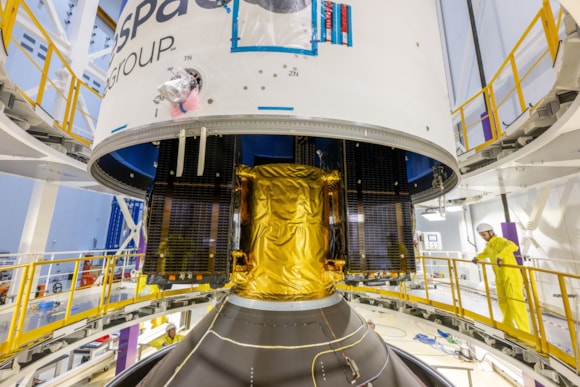UK Government boosts support for ExoMars mission

Following the Chancellor’s Autumn statement, the UK will play a lead role in Europe's ExoMars mission to the Red Planet. The ExoMars mission is one of the key missions under the remit of the UK Space Agency.
The Government's new commitment to the ExoMars programme amounts to £47.7m, alongside a similar amount for the International Space Station (ISS). This more than triples the sum offered as a "one-off" payment to the ISS two years ago. Also among the UK's increased commitments to the European Space Agency (ESA) was £130m to be spent on satellite telecommunications projects.
ExoMars is a robotic mission developed by ESA, with two mission components - an orbiter and landing demonstrator which are due for launch in 2016, and a scientific rover that will be launched in 2018. The rover will explore the planet, paying particular attention to its geochemistry and possible evidence of biology.
The University of Leicester has a strong involvement with the rover mission through the development of one of the key instruments, a Raman spectrometer, which is being built by a number of European partners, including Spain (lead), France and Germany. RAL Space and UK industry will also be involved in the development of the instrument.
Raman Spectrometer
The scientific aims of the Raman instrument are:
• to identify organic compounds in mineral matrices and search for life
• to identify the mineral products and indicators of biological activity
• to characterise mineral phases produced by water related processes, and
• to characterise igneous minerals and their alteration products
Professor Martin Barstow, Pro-Vice-Chancellor, Head of the College of Science & Engineering, Professor of Astrophysics & Space Science and President of the Royal Astronomical Society said: “The Autumn statement is a welcome demonstration of the Government's commitment to science investment. The decision to contribute an additional £47.7m to the ESA ExoMars programme is particularly important for the role of this University and wider UK involvement in the exploration of the Red Planet.
Professor Mark Sims, Professor of Astrobiology and Space Instrumentation at the University of Leicester said: “The announcement of £47.7m commitment to the ExoMars Programme from the Chancellor in his Autumn statement will help secure the 2018 rover mission in which University of Leicester plays a significant technical and scientific role in developing the Raman spectrometer for this mission.
“The ExoMars programme has struggled to raise funding for the two missions from the ESA member states and the UK’s additional commitment reinforces other additional contributions to secure the mission, allowing the instrument and programme development to proceed towards the 2018 launch.”
University of Leicester Involvement
The ExoMars rover, which houses the Raman spectrometer, will explore the surface of the planet, drilling up to 2m below the surface. The Raman instrument will investigate the resulting drill samples, determining the mineralogy and searching for organics including those that might be associated with life.
Dr Ian Hutchinson, a lecturer in the Department of Physics & Astronomy, leads the ExoMars instrument activities at Leicester. The team, which also includes Professor Howell Edwards and Dr Richard Ingley are currently working on the development of a camera system for the Raman instrument and lead the science activities related to the detection of organics. The Raman camera incorporates Charge Coupled Devices (CCDs) from e2v and electronics from RAL Space. The Raman spectrometer utilises laser light to probe molecular bonds within the sample and generates characteristic patterns (molecular ‘fingerprints’) that can be used to identify particular minerals and organic compounds in mineral matrices.
Professor Howell Edwards is also a member of the ExoMars Landing Site Selection Working Group and will work with an international team of scientists and engineers to determine where on the surface of Mars the rover should be deployed. In response to the positive news, Professor Edwards, who is an acknowledged international expert on the applications of Raman spectroscopy and has 1200 research papers in the literature, confirms the key analytical role of Raman spectroscopy as a first pass non-destructive technique on the ExoMars rover for the interrogation of Martian regolith specimens. The detection of molecular biomarkers in protective geological niche environments using the Raman laser spectrometer (RLS ) on the ExoMars mission will be the prime target for the search for extinct or extant life on Mars in this mission.
In this context, the research work currently being undertaken by members of Dr Hutchinson's group at Leicester on the characterisation of biomarker Raman spectral signatures from extremophilic organisms in terrestrial Mars analogue sites in hot and cold deserts is critically important for the future spectral interpretation of ExoMars mission data from the planetary surface and subsurface.
Also involved in the ExoMars project is Dr John Bridges, Reader in Planetary Science at the University of Leicester. Along with Professor Edwards, Dr Bridges is set to follow up his key role with the Mars Curiosity mission by helping to choose the target destination of the next Red Planet rover and will lead on gathering of the data.
There are a large number of engineering and scientific constraints to be considered in the selection of the 2018 site and over the next few years the scientists will gather a lot of data and consider which of the 4 shortlisted sites is best suited to the science aims of ExoMars. This is where the expertise of Professor Edwards and Dr Bridges comes in. Dr. Bridges has already been integral to NASA’s Mars Curiosity mission, since its launch in November 2011 and landing on August 2012.
He is part of a team from the Space Research Centre at the University of Leicester, the Open University and CNRS France, who are analysing data to determine the conditions associated with the presence of water and assess the past Habitability of Mars for microbial life.
As a result, he has gained invaluable insights into the most effective target areas for drilling. In a recent blog post, John says:
"One of the key things we are learning from MSL is about the importance of drilling and the preservation of organics in relation to the surrounding terrain. ExoMars should be able to drill down to 2m depth, helping our chances of avoiding the full effects of radiation from solar and galactic sources.
"However, results from Curiosity also show the likely importance of identifying sampling sites which have been protected by overlying rocks for most of their history, with only relatively recent exposure by wind erosion on the Martian surface."
Along with Professor Edwards, he will help to assess suggestions from the scientific community of possible landing sites for the ExoMars Rover mission which is proceeding via a series of workshops.
The suggested sites must meet a range of criteria laid out by ESA. For instance, the site must be ancient (more than 3.6 billion years old) and must show lots of evidence of longstanding or re-occurring water activity.












